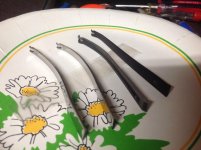Let's remember the question here was about modifying a mainspring. It wasn't about performing an action job, just modifying a factory spring. That's no big deal, and doesn't take rocket science or a degree in physics. I will say however that heating a spring for any purpose is a bad idea unless you understand a lot about metallurgy. Spring properties are made by heating to a certain temp, for a certain period of time, and using a certain type of quench. Miss any of these three important factors and the spring can either be too soft and just bend under pressure, or too brittle and break under pressure.
Now, on to the unasked, yet answered (?) question of action jobs and gunsmithing in general. A real gunsmith must be trained to work on all aspects of a firearm, from inspecting Damascus steel to fitting a Perrazi shotgun. However these people are few and far between. Just like the medical field has specialists, so does the gunsmithing field. For example, there are those who work on nothing but 1911's, and just like the medical field, these are the people you want working on your specific need. Doing a trigger job on a S&W isn't difficult, provided you are mechanically inclined and can read and more importantly follow instructions. I've worked on the actions of many 1911's and S&W revolvers. And although it was always this way, I'd now put my work up against anyone's. In fact paying a gunsmith for a trigger job was what started me doing my own when I completely dissatisfied with the quality of his work. But again, I posses the three traits I mentioned above, and never hesitated to shell out the bucks for specialized tools when needed. I liken doing an action job to replacing the brakes on a car. Any one with the traits mentioned above, and of course the proper tools, can do it, and for a lot less than the "professional" will charge. That in no way is meant to lessen the job done by a gunsmith (or an auto mechanic for that matter). I'm merely stating that doing an action job isn't magic, voodoo or some mystic ritual that only certain high priests can perform. If, however, you lack in the three areas I mentioned or don't have the proper tools, then I
strongly urge you to have a professional do the work, whether it's an action job or a brake job on your car. Botched results can have similar ends.

And no, I won't work on your gun because I no longer have a license and consider myself retired.



